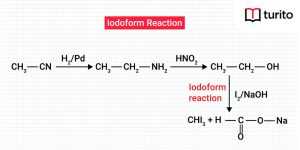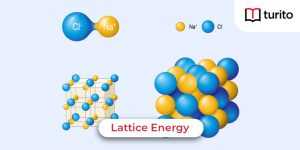Molecular Structure
A molecule’s three-dimensional form or arrangement is referred to as its molecular structure. Studying a chemical’s molecular structure may assist in identifying its polarity, volatility, state of matter, color, electromagnetism, and biological activity.
The optimal spatial orientation of covalent connections to atoms with two or more bonds determines the geometry. It should be mentioned that the favored spatial orientation of covalent connections between two atoms influences the structure of a molecule.
Perspective Drawings
Several spatial combinations may be viewed using a model. Perspective drawing may be used to portray these arrangements on paper.
A line connecting both bonded molecules specifies the direction of the bonding. Different types of lines in perspective pairing represent various bonds. Some of these bonds, as well as their lines and depictions, are shown below.
![]()
![]()
![]()
![]()
The carbon atom is generally the focal point of an arrangement. This implies that the bond orientation lines start with a carbon atom.
- A dashed line shows that the bond extends past the drawing surface’s plane.
- A bold-wedged line shows that the bond protrudes from the drawing surface’s plane.
- A solid line implies that the connection occurs in the drawing surface’s plane.
- A wavy line implies that the bond’s formation is unclear.
- A dotted line shows that the bond is partially bonded, such as a hydrogen bond.
We know that all atoms demand eight valence electrons. After bond pairs are created, the left-over electrons are integrated as lone pairs around the focal carbon atom. As per the octet rule, this can be calculated by accounting for the bond pairs and subtracting them from the valence electrons. Not giving importance to the lone pairs of a compound can create a lot of ambiguity. Methane and water, for example, have almost identical structures. The primary distinction is in the electron pairs in the valence shell. This is depicted in the graphic below.


VSEPR Theory
The valence shell electron-pair repulsion theory (VSEPR theory) predicts the three-dimensional structure of a molecule based on the bonds and unshared electrons pairs in its Lewis structure. The VSEPR model predicts that electron pairs will organize together to reduce mutual repulsion. To put it another way, the shared electrons are as far apart as they can be by maximizing the distance between them. The electrostatic repulsion between the shared electrons is minimal when the locations of high electron density are as far apart as feasible.
The configuration of electron pairs surrounding each core atom is predicted by VSEPR theory. However, we must remember that the theory solely addresses electron-pair repulsive forces.
For example, let us use VSEPR theory to determine the molecular configuration of a BeF2 molecule. BeF2‘s Lewis structure exhibits just two electron pairs surrounding the core beryllium molecule. Electron pairs are as far away as feasible with two bonds and no unbonded or lone pairs of electrons on the core atom. The electron-pair repulsive forces between these zones of high electron density are decreased to a minimal level because they’re on opposite ends of the center atom.

Features of the VSEPR Theory
The following are the key characteristics of VSEPR theory:
- The valence shell electron pairs (bonded or unbonded) surrounding the core atom determine the molecule’s structure.
- Electron pairs in the valence shell will oppose each other due to the negative charge in orbit.
- The electron pairs’ locations in orbit surrounding the core atom are chosen to reduce resistance and increase their separation.
- The intensities of the various forms of electrical repulsions are listed below in the following order:
Lone pair – Lone pair > Lone pair – Bond pair > Bond pair – Bond pair
- The electrostatic repulsion alters the bond angles of the particular molecule.
- When two electrons are as distant as feasible, their electrical repulsion is minimized.
Molecular Structure vs. Electron-pair Geometry
It is critical to understand that the electron-pair configuration surrounding a core atom is not equivalent to its molecular structure. The electron-pair geometries depicted explain all locations where electrons may be found, including bonds and lone pairs. The placement of the atoms is described by molecular structure.
The molecular structure comprises the arrangement of the atoms in the molecule. The situation is different when lone pairs are present. However, in the absence of lone pairs, the electron-pair structures will be identical to the molecular structures.
For instance, methane (CH4) is the main constituent of natural gas. It contains four bond pairs surrounding the core carbon atom. The electron-pair geometry, like the structure of the molecule, is tetrahedral. On the contrary, the ammonia compound, NH3, has four electron pairs connected to the nitrogen nucleus and hence possesses a tetrahedral electron-pair structure. Apart from the three hydrogen atoms, it contains a lone pair that is not part of the chemical structure. This lone pair alters the form of the molecule.
Order of Repulsions
Small alterations from the ideal angles might emerge from changes in attraction between different areas of electron density. These deviations are predicted by VSEPR theory by defining an order of electrostatic repulsion. The following is the order of electron-pair repulsive force, from largest to smallest repulsion:
lone pair-lone pair > lone pair-bonding pair > bonding pair-bonding pair
The quantity of space taken up by various areas of electrons is determined by order of repulsions. A single electron pair takes up more area than electrons that exhibit a triple bond; electrons that are triple bonded take up more area than those in a double bond, and so on. The sizes are listed in the following sequence, in descending order:
lone pair > triple bond > double bond > single bond
Structure of a Molecule Classification
1. Linear molecular configuration: Two molecules are connected to the center atom in this configuration. So they organized themselves in the other way to decrease their aversion. This structure’s bond angle is 180. Examples are BeCl2, MgCl2, and so on.
2. Trigonal planar molecular configuration: Three molecules are connected to a central atom in this form of the molecule. To decrease their repulsion, they are positioned near the extremities of an equilateral triangle. This molecule has a bond angle of 120. For instance, BF3, BCl3, AlF3, and so on.
3. Tetrahedral molecular configuration: In tetrahedrally bonded molecules, a central atom is situated in the middle, with four atoms at the tetrahedron’s four edges. The structure’s bond angle is 109.5. Examples include CH4, CCL4, and others.
4. Molecular geometry of trigonal bipyramidal: Consider the case of PF5. By distributing electrons evenly towards the corner, the repulsions can be prevented in a trigonal pyramid. Three locations are located along the midline of a trigonal bipyramid. The two sites are parallel and perpendicular to the equatorial region. The bond angle is between 90 and 120 degrees.
5. Molecular geometry of the octahedron: The form of compounds having six molecules or ligands uniformly grouped around a central atom, forming the corners of an octahedron, is described by octahedral molecular geometry, also known as square bipyramidal. The prefix octa comes from the octahedron’s eight surfaces. The bond angle is 90 degrees.. SF6, TeF6, and so forth.
What do you mean by regular and irregular or distorted geometry?
According to the VSEPR hypothesis, bonded molecules have two configurations: regular and irregular.
- Regular geometry: Covalently bonded molecules have regular geometry if all similar electron bond pairs accompany the core atom. The bond pairs’ repelling interactions cancel each other out. For example, CH4 and BF3.
- Irregular geometry: Covalently bonded molecules have irregular geometry if the core atom is accompanied by bond pairs of various atoms or bonds and lone pairs of electrons. In such a case, the interactions between bonds do not cancel each other out. For example,PF5 and CHCl3.

Conclusion
The molecular structure is the 3D form or arrangement of a molecule. The preferred physical configuration of covalent connections between two atoms with two or more bonds influences the structure of a molecule. Perspective sketching may be used to portray these arrangements on paper. A line connecting both linked atoms specifies the direction of the connection in perspective drawing. Several methods for determining the bond length as well as the bond angle have been developed. The geometries may be predicted hypothetically using valence shell electron pair repulsion theory (VSEPR theory).
Frequently Asked Questions about Molecular Structure
Q1. What are the bond length and bond angle?
Answer: A bond angle is an angle formed by any two bonds that share the same atom and is commonly expressed in degrees. Bond length is the distance along a linear path between the nuclei of two bound atoms. Bond lengths are expressed in Angstroms or picometers.
Q2. What are the necessary conducive factors for the creation of a covalent bond?
Answer: The following components are necessary for the creation of covalent compounds:
- Atoms that have low activation energy.
- The chemicals generated have a high crystalline enthalpy.
- Inorganic atoms have a good electron gain enthalpy.
Q3. What is the molecular structure of water?
Answer: The core element in the Molecule of water is oxygen. Oxygen has a valency of six. Two of these ions interact with two atoms of hydrogen to create bonds. Thus, the water molecule has two bond pairs and two non-bonding (lone) pairs of electrons. The structure is hence tetrahedral.

Relevant Articles
Butanoic Acid – Structure, Properties, Uses
Butanoic Acid The carboxylic acid, butanoic acid, has the structural …
Butanoic Acid – Structure, Properties, Uses Read More »
Read More >>What is Iodoform? Characteristics and Uses
Iodoform The formula for Iodoform is CHI3. It is biotic …
What is Iodoform? Characteristics and Uses Read More »
Read More >>Lattice Energy – Explanation, Factors & Formulas
Lattice Energy Lattice energy evaluates the intensity of the ionic …
Lattice Energy – Explanation, Factors & Formulas Read More »
Read More >>Lead Acetate – Definition, Properties, Uses
Lead Acetate Have you ever licked lipstick when you sketch …
Lead Acetate – Definition, Properties, Uses Read More »
Read More >>





















Comments: